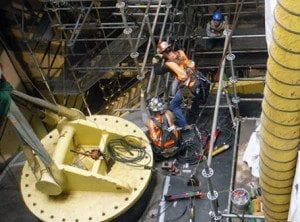CONVERTING NON-POWERED DAMS
Only 3 percent of the nation’s 80,000 dams currently generate electricity, and as we move to a clean energy economy, it is vital that we tap these unused resources.
By installing electricity generation equipment at these currently non-powered dams, America’s hydropower industry can tap the waters already flowing through this existing infrastructure. Converting these dams expands our supply of domestic, renewable energy and maximizes the benefits of our existing infrastructure while continuing to safeguard the state of our watersheds.
Developing these untapped hydropower resources would create and support hundreds of thousands of good paying jobs that cannot be outsourced. A 2009 Navigant study indicates that installing 60,000 MW would result in 1.4 million cumulative jobs by 2025. Ten thousand of those megawatts will come from converting non-powered dams, creating jobs in every region across the country.

Project Highlight: Missouri River Energy Services
In August 2014, Missouri River Energy Services broke ground on their Red Rock Hydroelectric Project.
Once completed, it will be the second largest hydropower project in Iowa and provide enough affordable clean energy to meet the needs of 18,000 homes.
Building on an Army Corps of Engineers dam, MRES is maximizing the public benefit of existing non-powered water infrastructure by adding clean, reliable power. With only 3 percent of the nation’s dams equipped to generate electricity, the Department of Energy estimates this type of low-impact development could add 12,000 MW of hydropower capacity to the nation’s grid.
This project’s inclusion in President Barack Obama’s Climate Action Plan ensured that environmental reviews were balanced with the goals of reducing carbon emissions and providing additional clean energy promptly.
Project Highlight: American Municipal Power
American Municipal Power (AMP) is leading the way in expanding hydropower capacity in the Midwest, with plans to convert six dams along the Ohio River that previously had no electric generating equipment. Combined, the projects will add 350 MW of new renewable generation and represent the largest development of new run-of-river hydropower in the country.

Among the three projects that have already begun construction is the Smithland Locks and Dam. The $400 million Smithland project will have a capacity of 72MW. As many as 400 construction workers will be employed to build the project, and 7-9 permanent operating positions will also be established.
Two other projects are also underway, at the Captain Anthony Meldahl Locks and Dam and the Cannelton Locks and Dam, and another three — the RC Byrd, Willow Island and Pike Island dams — are in development.


